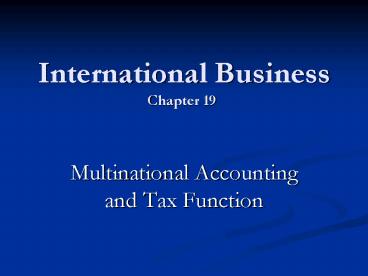International Business Chapter 19 - PowerPoint PPT Presentation
1 / 18
Title:
International Business Chapter 19
Description:
The Financial Accounting Standards Board (FASB) establishes accounting standards ... FASB Statement No. 52 describes how companies must translate their foreign ... – PowerPoint PPT presentation
Number of Views:41
Avg rating:3.0/5.0
Title: International Business Chapter 19
1
International BusinessChapter 19
- Multinational Accounting and Tax Function
2
Introduction
- Accounting is defined as
- A service activity whose function is to provide
quantitative information, primarily financial in
nature about economic entities that is intended
to be useful in making economic decisions in
making reasoned choices among alternative courses
of action.
Assets Liabilities Owners Equity
3
Accounting Standards
- The Financial Accounting Standards Board (FASB)
establishes accounting standards in the United
States. The Accounting information should
consist of - Investment and credit decisions
- Assessment of cash flow prospects
- Evaluation of enterprise resources, claims to
those resources, and changes in them
4
Accounting Standards (cont.)
- The International Accounting Standards Committee
(IASC) is an international private sector
organization that sets accounting standards.
They identify the major users of financial
information as
- Investors
- Employees
- Lenders
- Suppliers
- Customers
- Government and their agencies
- Public
5
Accounting Standards (cont.)
- Generally Accepted Accounting Principles (GAAP)
are those standards established in each country
that must be followed by companies in generating
their financial statements. - Counties differ on the level of secrecy and
transparency in which companies are required to
disclose financial information to the public.
6
Cultural Differences
- Countries differ greatly on the degree of
optimism vs. conservatism in valuing assets and
recognizing income. - German companies are very conservative
- British and U.S. companies are optimistic
7
Cultural Differences (cont.)
- Major reporting issues faced by Multitnational
firms include - Differences in language and currency
- Types of statements
- Format of the financial statements
- Extent of footnote disclosures
- Underlying GAAP on which the financial statements
are based
8
Cultural Differences (cont.)
- Ways to deal with accounting and reporting
differences - Mutual recognition
- Reconciliation to local GAAP
- Recast financial statements in terms of local GAAP
9
Harmonization
- Major forces leading to harmonization
- A movement to provide information compatible with
the needs of investors - The global integration of capital markets
- The need for MNEs to raise capital outside the
home-country - Regional political and economic harmonization
10
Translation
- Translation is the process of restating
foreign-currency financial statements - FASB Statement No. 52 describes how companies
must translate their foreign-currency financial
statements into dollars - All U.S. companies and those that are listed on a
U.S. exchange must use Statement No. 52
11
Translation (cont.)
- Translation is done by either of two methods
- depending on the function currency of the
foreign operation - Current-rate method
- Temporal method
- Functional currency is the currency of the
primary economic environment in which the entity
operates
12
Translation (cont.)
- The Current-rate method is used when the local
currency is the functional currency. - Translate all assets and liabilities at the
current exchange rate, which is the spot exchange
rate on the balance sheet date - All income items are translated at the average
exchange rate - Owners equity is translated at the rates in
effect when the company issued capital stock and
accumulated retained earnings
13
Translation (cont.)
- The temporal method is used when the parents
reporting currency is the functional currency - Only monetary assets and liabilities are
translated at the current exchange rate - Inventory and property, plant, and equipment are
translated at the historical exchange rates - Most income statement accounts are translated at
average exchange rates with the exception of cost
of goods sold and depreciation, which are
translated at the appropriate historical exchange
rates
14
Translation (cont.)
- A translation adjustment will need to be made
due to the changes in exchange rates. - With the current-rate method the translation gain
or loss is recognized in owners equity - With the temporal method the translation gain or
loss is recognized in the income statement
15
Taxes
- Taxes influence a companys profitability and
cash flow therefore tax planning is a critical
dimension for any business. Taxation can
influence business decision in the following
areas - Location of the initial investment
- Choice of operating form
- Legal form of the new enterprise
- Method of financing
- Method of setting transfer prices
16
Taxes (cont.)
- Companys should become familiar with the tax
practices of the countries in which they operate - Separate entity approach income is taxed when
earned, both company and individual - Integrated system dividend credit given to
shareholders
17
Taxes (cont.)
- Exporting companies seek to set up a Foreign
Sales Corporation (FSC) to shelter some of its
income from taxation. To qualify, a substantial
economic activity must occur outside the United
States. - Maintain a foreign office
- Operate under foreign management
- Keep a permanent set of books at the foreign
office - Conduct foreign economic processes
- Be a foreign corporation
18
Taxes (cont.)
- Tax strategies include
- Companies should set up branches in early years
to recognize losses - Companies should set up subsidiaries in later
years to shield profits































